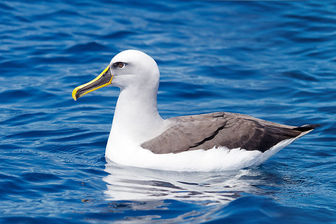Buller's Albatross
Mollymawks are a type of Albatross that belong to Diomedeidae family and come from the Procellariiformes order, along with Shearwaters, Fulmars, Storm-petrels, and Diving-petrels. They share certain identifying features. First, they have nasal passages that attach to the upper bill called naricorns. Although the nostrils on the Albatross are on the sides of the bill. The bills of Procellariiformes are also unique in that they are split into between 7 and 9 horny plates. Finally, they produce a stomach oil made up of wax esters and triglycerides that is stored in the proventriculus. This is used against predators as well as an energy rich food source for chicks and for the adults during their long flights.

Original source: JJ Harrison (http://www.noodlesnacks.com/)Camera location
Author: JJ Harrison (http://www.noodlesnacks.com/)Camera location
The Buller's Albatross is classified as Near Threatened (NT), is close to qualifying for or is likely to qualify for a threatened category in the near future.
Buller's Albatross or Buller's Mollymawk, Thalassarche bulleri, is a small mollymawk in the albatross family. It breeds on islands around New Zealand, and feeds in the seas off Australia and the South Pacific. Contents - * 1 Taxonomy * 2 Etymology * 3 Description * 4 Behavior * 4. More
Before now, two subspecies of Buller's Albatross were recognized: Diomedea bulleri bulleri which breeds on the Solander Island (4,000-5,000 prs, southern tip of New Zealand) and the Snares Islands (8,500 prs, due south of New Zealand) and Diomedea bulleri platei which breeds on the Chatham Islands (18,000 prs, east of New Zealand) with a smaller number on Three Kings Island (less than 20 prs, at the northern tip of New Zealand). More
Buller's Albatross or Buller's Mollymawk, Thalassarche bulleriReproduction The Buller's Albatross is colonial, nesting generally on cliffs, steep coastal terraces, grassy meadows, and tussock covered hills. Birds in the Snares also nest under trees inland. The nest is mound of soil, grass and roots and is set into depressions in the breeding area. Breeding begins in December. More
Buller's albatross sitting on the water Breeding pairs remaining in the world: 32,000 Where do they breed?: Islands off New Zealand Wingspan: 200-213 cm Length (beak to tail): 76-81 cm Average lifespan: Up to 30 years Diet: It feeds mostly on fish, squid and tunicates (barrel-like filter feeders), but also octopuses, shrimps and lobsters Scientific name:Thalassarche bulleri Threat level: Near Threatened Why they need your help Although More
Increased numbers of Buller's albatross on the Snares Islands, south of New Zealand, is giving hope that threatened albatross species could yet survive the world's fishing fleets. Sea bird scientist Paul Sagar, who recently returned from the Snares, said a head count showed there were now about 8700 Buller's breeding pairs. That was up more than 100 per cent on numbers when regular counts began in 1969. More
Albatross complex from Buller's Albatross irrespective of its age: The black skin across the base of the culmen forms an obvious black line between the yellow of the bill and the silver-grey forecrown. Salvin's Albatross (Thalassarche cauta salvini) on Midway, left, and White-capped Albatross (T.c.cauta) off Point Arena, California, right. Note the grey wash to the head of the Midway bird and the white-capped appearance of the California bird, as well as the yellow base to the culminicorn. More
Buller's Albatross released at sea = Vet Nurse Amy releasing the Bullers Albatross Click on image to enlarge Vet Nurse Amy releasing the Bullers Albatross 25 November 2009 A Buller’s Albatross fledging was released into the wild today after being nursed to back to health at Taronga’s Wildlife Hospital. More
The Buller's Albatross is a typical mollymawk, its plumage, reminiscent to that of a gull, with a dark back and upperwing, white undersides. Its head and neck are silver coloured grey with black and white areas around the eye. The bill is black with yellow ridges and tip. More
Family : Diomedeidae
Genus : Thalassarche
Species : bulleri
Authority : (Rothschild, 1893)

